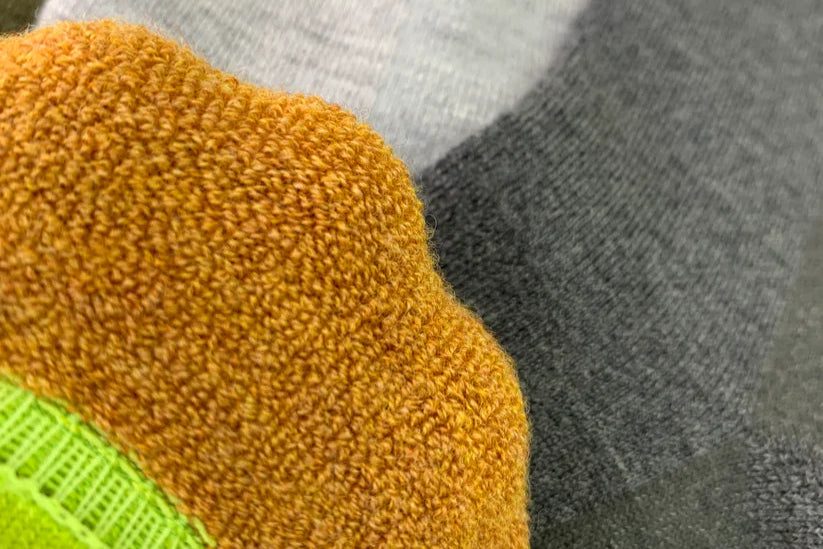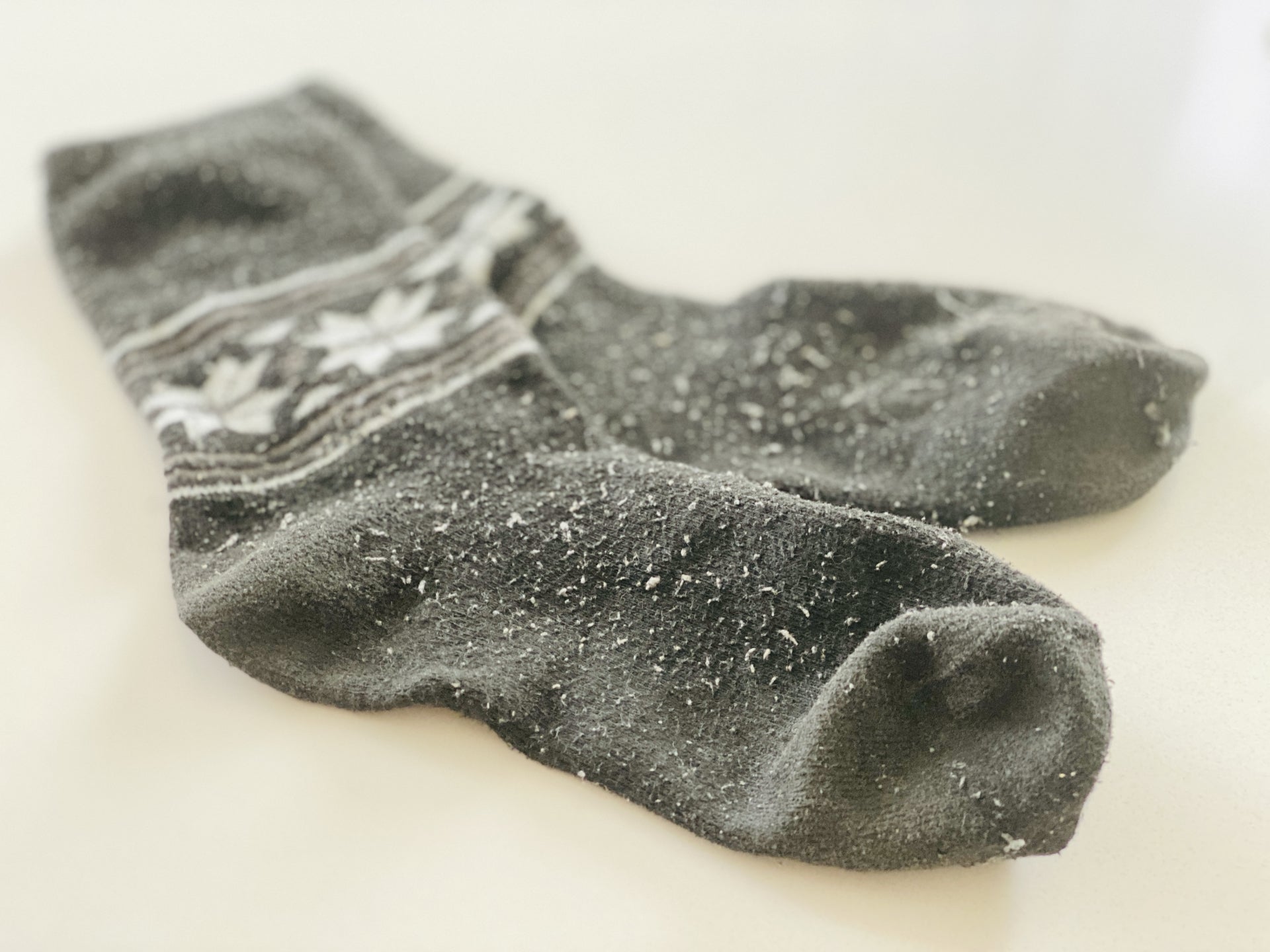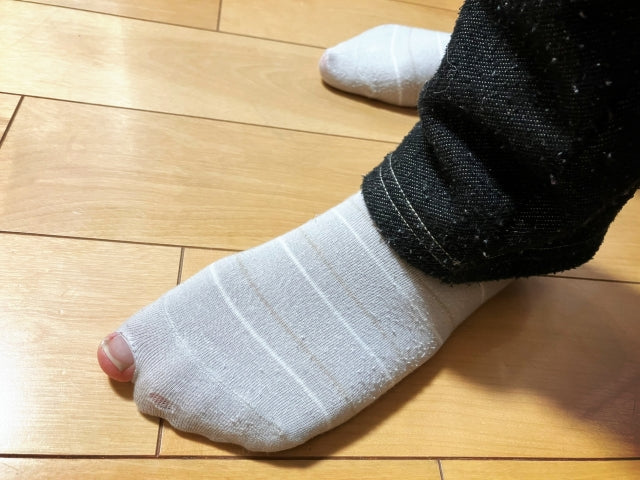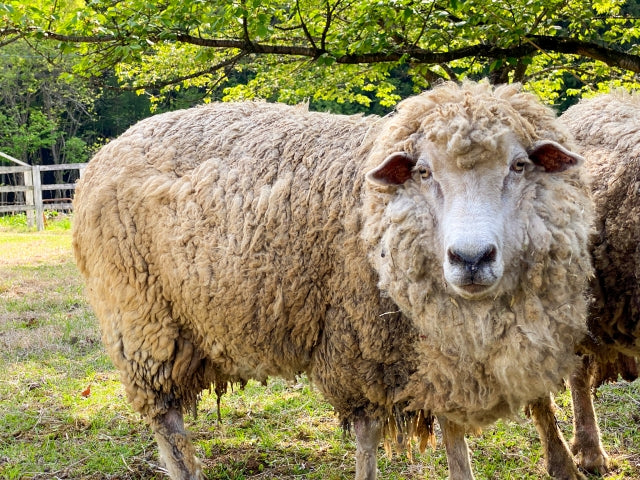
My name is Hiroki and I am a new staff member at OLENO.
Today, I would like to summarize what I have researched and heard about the yarn (materials) used in socks.
When I joined the company, I had the opportunity to see the production process of OLENO socks, and for the first time I learned that various threads are attached to the machine to make one pair of socks. It seems that threads are skillfully combined to give them various properties, and depending on the combination, the possibilities are endless .
The official reason is that I will be able to learn about the characteristics of each thread , as I will be involved in the development of new OLENO products in the future. (The hidden reason is that I feel like I will have to study within this month or else I will be in trouble.)
The "usage" and "best usage scenarios" vary depending on the material, so if you have never paid attention to materials before, we hope you will take a look and learn with us.
【table of contents】
①Material characteristics
· wool
· Angola
· cashmere
· cotton
· silk
· acrylic
· nylon
· linen
②What is the best material for socks?
①Characteristics of each material
wool
Wool is a well-known high-performance fiber that is known as a "breathing fiber." It has temperature regulating properties, absorbing and releasing moisture according to the humidity of the outside air to provide comfort .
Wool is often thought of as being only for winter clothing because of its high heat retention, but it is actually more suitable for summer . Wool is also characterized by its sweat-wicking and low thermal conductivity, so it is not only not cold but also heat (heat) resistant . Although it has many attractive features, it also has the disadvantages of being vulnerable to damage caused by friction and washing in water, and being prone to shrinkage .
It provides a lot of detail about wool, so if you're interested, be sure to check it out.
Uncovering the true nature of "wool" that you see more than 10 times in winter
Merino wool is a high-quality wool. We looked into its pros and cons
| Elasticity | ○ |
| Durability | × |
| Thermal insulation | ◎ |
| Moisture absorption | ◎ |
Commonly used items: sweaters, suits, coats, scarves, gloves, etc.
Angola
Angora is a type of animal fiber made from the hair of Angora goats. It has a silky luster and a soft feel . It has excellent insulation and sweat absorption properties, and is said to have about three times the heat retention of regular wool . However, because it is a very delicate material, it is often blended with wool and nylon.
| Elasticity | × |
| Durability |
× |
| Thermal insulation | ◎ |
| Moisture absorption | ◎ |
Commonly used items: sweaters, blankets, scarves, etc.
cashmere
It is an animal fiber obtained from cashmere goats. It has excellent heat retention and moisture control properties and is said to be the best in the animal fiber world, but it is also one of the most difficult to handle . It often loses its shape and pills , and is prone to stains when wet . To avoid damage, it may be best to use it when you want to splurge, such as when going out or on special occasions, rather than for everyday use.
| Elasticity | ◎ |
| Durability | × |
| Thermal insulation | ◎ |
| Moisture absorption | ◎ |
Popular items: Winter clothing such as knitted sweaters, coats, and scarves
Cotton
Cotton is a plant fiber that is often used for summer socks. It feels nice against the skin , and its hollow structure makes it highly absorbent and breathable . Therefore, it absorbs sweat well and feels cool to wear , making it ideal for clothing that comes into contact with the skin, such as innerwear. However, on the other hand, it does not dry quickly and is difficult to dry . Be careful, as it can become damp and steamy if worn for a long time. It is also prone to wrinkling and shrinking.
| Elasticity | × |
| Durability | ○ |
| Thermal insulation | ○ |
| Moisture absorption | ○ |
Commonly used items: underwear, towels, sheets, etc.
Silk
Known as the queen of fibers, this natural fiber is made from the cocoons produced by silkworm moth pupas. It is characterized by its glossy texture and smooth feel that glides easily through the hands. It is actually similar to human skin and has a high water retention, so it blends well with the skin and has excellent cosmetic properties . It also has natural bacteriostatic properties, making it easy for people with sensitive skin or atopic dermatitis to wear . Its drawbacks are that it is prone to staining and can yellow when exposed to sunlight (due to its low friction and ability to absorb around 90% of UV rays).
| Elasticity | × |
| Durability | × |
| Thermal insulation | ○ |
| Moisture absorption | ◎ |
Commonly used items: Underwear, pajamas, pillows, duvet covers, etc.
polyester
Polyester is the most widely used synthetic fiber in Japan. It is a strong fiber that does not shrink or lose its shape easily , and is said to be resistant to impacts. (Nylon is resistant to pulling.) It is not that resistant to heat, so it is best to avoid high-temperature ironing and using a dryer . Also, it dries quickly, so it feels smooth to the touch and does not wrinkle easily, but it is prone to generating static electricity in dry seasons.
| Elasticity | × |
| Durability | ○ |
| Thermal insulation | △ |
| Moisture absorption | × |
Commonly used items: A wide range of clothing, including shirts, pants, dresses, jackets, bedding, curtains, carpets, bags, and tents.
acrylic
A synthetic fiber made from petroleum. It is similar to wool, and is elastic and soft to the touch, so it is often used for winter clothing such as fleece. Unlike wool, which is an animal fiber, it is resistant to insect damage , but it has low water absorption and does not absorb sweat, so wool is more suitable for socks and other items.
| Elasticity | △ |
| Durability | ○ |
| Thermal insulation | ◎ |
| Moisture absorption | × |
Commonly used items: knitwear such as cut and sewn items, underwear, sweaters, blankets, carpets, etc.
nylon
Nylon is said to have first been used for women's stockings. It is a very strong fiber and is said to be resistant to repeated deformation such as folding, oil, mold, and pests. However, like polyester, it is very sensitive to heat , so it is best to avoid using a dryer for nylon socks. Needless to say, you should also iron at a low temperature.
| Elasticity | ◎ |
| Durability |
◎ |
| Thermal insulation | × |
| Moisture absorption | × |
Commonly used items: stockings, outerwear, rain gear, sportswear, etc.
linen
Among all natural materials, linen is unmatched in durability . It is said that if you take good care of it, it can last for 100 years, and it is resistant to repeated washing . The more you use it , the softer it becomes, and the more it feels and feels on your skin . However, it has the disadvantages of wrinkling easily, which is common among plant fibers, and shrinking at temperatures above 30 degrees . However, it also has excellent moisture absorption and quick-drying properties, and because the fibers have cavities, it has excellent heat retention and breathability, so it may be the best of all the materials we have introduced.
| Elasticity | × |
| Durability |
◎ |
| Thermal insulation | ○ |
| Moisture absorption | ◎ |
Commonly used items: Clothes such as blouses and shirts, bedding such as sheets and pillowcases, tablecloths, napkins, etc.
②What is the best material for socks?
So, which material is best for socks? It probably depends on what you prioritize.
| Mountain climbing and outdoor activities | Merino wool |
| Sports | Polyester + nylon blend |
| Everyday Use | Cotton or cotton + polyester |
| Emphasis on luxury | Cashmere or silk blend |
Merino wool , which has excellent heat retention, breathability, moisture absorption, and odor resistance, is ideal for mountain climbing and outdoor activities , while a polyester + nylon blend, which is quick-drying and durable, is ideal for sports .
For everyday use , cotton socks or cotton + polyester socks are suitable as they are affordable, gentle on the skin, and highly absorbent. On the other hand, for special occasions such as weddings or dinners at high-end restaurants, why not choose cashmere or silk-blend socks ?
We have looked at various fibers used in socks and clothing (there are probably many more).
I think that even now, textile companies are searching for the perfect combination that makes use of the strengths of each fiber while compensating for their weaknesses.
Each fiber has its advantages and disadvantages, and I felt that it was our industry's responsibility to find ways to utilize them effectively in the human world, which is more complex than the plant or animal kingdoms.
I don't think the knowledge I've introduced this time is particularly necessary in life, but it would be cool to be able to choose socks based on their material, so I'm going to make sure I learn as much as I can and keep wearing the best socks!
[Socks Trend NEWS]
・Wool socks for summer are designed to be as comfortable as possible.
・How to prevent wool from being eaten by moths and what to do after it has been eaten





